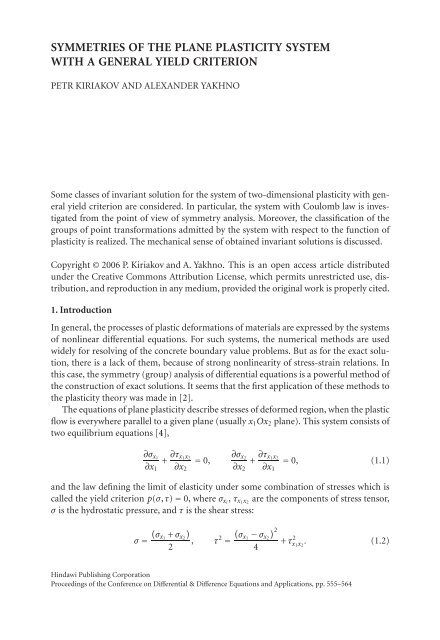DIFFERENtIAl & DIFFERENCE EqUAtIONS ANd APPlICAtIONS
DIFFERENtIAl & DIFFERENCE EqUAtIONS ANd APPlICAtIONS
DIFFERENtIAl & DIFFERENCE EqUAtIONS ANd APPlICAtIONS
You also want an ePaper? Increase the reach of your titles
YUMPU automatically turns print PDFs into web optimized ePapers that Google loves.
SYMMETRIES OF THE PLANE PLASTICITY SYSTEM<br />
WITH A GENERAL YIELD CRITERION<br />
PETR KIRIAKOV AND ALEXANDER YAKHNO<br />
Some classes of invariant solution for the system of two-dimensional plasticity with general<br />
yield criterion are considered. In particular, the system with Coulomb law is investigated<br />
from the point of view of symmetry analysis. Moreover, the classification of the<br />
groups of point transformations admitted by the system with respect to the function of<br />
plasticity is realized. The mechanical sense of obtained invariant solutions is discussed.<br />
Copyright © 2006 P. Kiriakov and A. Yakhno. This is an open access article distributed<br />
under the Creative Commons Attribution License, which permits unrestricted use, distribution,<br />
and reproduction in any medium, provided the original work is properly cited.<br />
1. Introduction<br />
In general, the processes of plastic deformations of materials are expressed by the systems<br />
of nonlinear differential equations. For such systems, the numerical methods are used<br />
widely for resolving of the concrete boundary value problems. But as for the exact solution,<br />
there is a lack of them, because of strong nonlinearity of stress-strain relations. In<br />
this case, the symmetry (group) analysis of differential equations is a powerful method of<br />
the construction of exact solutions. It seems that the first application of these methods to<br />
the plasticity theory was made in [2].<br />
The equations of plane plasticity describe stresses of deformed region, when the plastic<br />
flow is everywhere parallel to a given plane (usually x 1 Ox 2 plane). This system consists of<br />
two equilibrium equations [4],<br />
∂σ x1<br />
∂x 1<br />
+ ∂τ x 1x 2<br />
∂x 2<br />
= 0,<br />
∂σ x2<br />
∂x 2<br />
+ ∂τ x 1x 2<br />
∂x 1<br />
= 0, (1.1)<br />
and the law defining the limit of elasticity under some combination of stresses which is<br />
called the yield criterion p(σ,τ) = 0, where σ xi , τ x1x 2<br />
are the components of stress tensor,<br />
σ is the hydrostatic pressure, and τ is the shear stress:<br />
( )<br />
( ) 2<br />
σx1 + σ x2<br />
σ = , τ 2 σx1 − σ x2<br />
=<br />
+ τx 2 2<br />
4<br />
1x 2<br />
. (1.2)<br />
Hindawi Publishing Corporation<br />
Proceedings of the Conference on Differential & Difference Equations and Applications, pp. 555–564

















